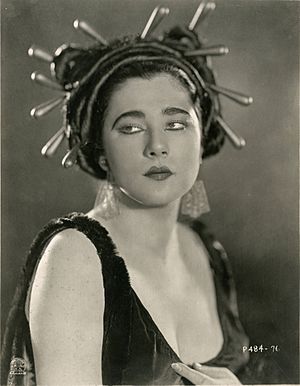Nita Naldi facts for kids
Nita Naldi (born Mary Nonna Dooley; November 13, 1894 – February 17, 1961) was an American stage performer and silent film actress. She was famous for playing a "vamp" character. A "vamp" was a mysterious and charming woman who often led men into trouble. This type of character was first made popular by actress Theda Bara.
Contents
Early Life and Stage Beginnings
Nita Naldi was born in New York City in 1894. Her parents, Julia and Patrick Dooley, were from Ireland. She was known as Nonna when she was young. Her great aunt, Mary Nonna Dunphy, was a nun who started a school called Academy of the Holy Angels. Nonna herself went to this Catholic school in 1910.
In 1915, Nonna's mother passed away. Nonna then had to take care of her two younger siblings. To earn money, she worked as an artist's model and a clothing model. Soon, she started performing in vaudeville shows. Vaudeville was a popular type of entertainment with different acts like singing, dancing, and comedy.
By 1918, she was a chorus girl in a Broadway show called The Passing Show of 1918. A chorus girl is a dancer who performs in a group. This led to more stage jobs, and she joined the famous Ziegfeld Follies in 1918 and 1919. Around this time, Nonna Dooley changed her name to "Nita Naldi." She got the name from a childhood friend. After a successful performance in a play called The Bonehead, she was offered a role in another play, Opportunity, in 1920.
Becoming a Silent Film Star
Naldi soon started acting in films. She had small roles in several movies. Then, she got a big break. She was cast as an interesting character named Gina in the 1920 film Dr. Jekyll and Mr. Hyde. This movie starred the famous actor John Barrymore. Barrymore reportedly saw her dancing and suggested her for the role. Her performance in this film helped her get more acting chances.
In 1922, Nita Naldi was chosen for the role of Doña Sol in the movie Blood and Sand. This film was based on a novel by a Spanish author. It was her first time working with the very popular actor Rudolph Valentino. The movie was a huge hit! It made Naldi famous for playing "vamp" characters. This image stayed with her throughout her career.
Naldi and Valentino were never a couple in real life. She became friends with Valentino's wife, Natacha Rambova. However, their friendship ended when the Valentinos divorced.
While Valentino was not making films for a while, Naldi took on other important roles. One of these was in the movie The Ten Commandments (1923), directed by Cecil B. DeMille. When Valentino returned to acting, she joined him for his last film with their company, A Sainted Devil (1924).
In 1924, Naldi and the Valentinos traveled to France for research for a film that was never made. When they returned, they made the movie Cobra. This film was not very popular. It was the last movie where Naldi and Valentino acted together.
After Valentino signed a new contract, his wife Natacha Rambova was given her own film to direct. Naldi starred in Rambova's 1925 movie What Price Beauty?. This film is notable because it was the first movie appearance for actress Myrna Loy.
After finishing another film, Naldi went to France for a vacation. There, she married J. Searle Barclay. Even though people thought she might retire, Naldi continued to make several films. This included The Mountain Eagle (1926), which was directed by Alfred Hitchcock. Naldi made two more films in France and one in Italy before she stopped acting in movies. Even though she had a good voice, she never made a "talkie," which is a movie with sound.
Later Years and Stage Comeback
After leaving films, Nita Naldi faced some money problems. She returned to the stage in 1933, appearing in plays like Queer People and The Firebird. She was considered for a role in the movie For Whom the Bell Tolls in 1942, but she did not get the part. She never made another film.
In 1952, she had an important role in a play called In Any Language. In 1955, she helped actress Carol Channing learn how to play a "vamp" character for a new musical called The Vamp. Carol Channing was nominated for an award for her role in that musical.
Naldi also appeared on a television series called Omnibus in the 1950s. She supported Adlai Stevenson in his campaign for president in 1952.
Personal Life
In 1929, Nita Naldi married J. Searle Barclay in France. They had known each other for about ten years. Naldi returned to the United States two years later. She did not talk much about Barclay publicly until after he passed away in 1945.
Despite rumors in Hollywood, Naldi always said she was never romantically involved with Rudolph Valentino or John Barrymore. She did not have any children.
Death and Recognition
Naldi spent her last years in New York City. She passed away from a heart attack in her hotel room on February 17, 1961. She was buried in the family plot at Calvary Cemetery in Queens, New York.
For her important work in the film industry, Nita Naldi has a star on the Hollywood Walk of Fame. It is located at 6316 Hollywood Boulevard.
|
See also
 In Spanish: Nita Naldi para niños
In Spanish: Nita Naldi para niños





